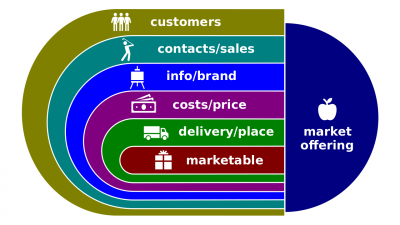Marketable
A marketing mix (alternatively known as product model, marketable compound, and, when already marketed, marketed compound; hereinafter, the Mix) is a model representing distinguishable components of any marketable. In other words, the Mix is a combination of components of a marketable that a business controls in order to influence consumers to purchase this marketable.
Contents
Components
Deliverable
deliverable, which can be divided in an unpackaged deliverable and packaging
Delivery
- Product delivery. The action of delivering marketables either ordered or for sale. Delivery personnel may be incorporated and important for this delivery.
Charge
- Product charge. A payment asked for a marketable. Not only its price, but also financing and acceptable payment methods may be incorporated in and important for this charge.
One-way communication
- Product presentation. The proffering or giving of a marketable to its potential consumers, particularly, through product manuals, official website, and public relations. Branding is the marketing practice of creating a name, symbol, or design that identifies and differentiates a marketable from other marketables.
Basic tools
Several business tools are used to capture the Mix in marketing products.
The 4P's
- Product refers to the deliverable that its seller offers for sale. This may include its features, benefits, style, design, branding, packaging, services, warranties, guarantees, life cycles, investments and returns.
- Price refers to the total cost to customer to acquire the product, and may involve both monetary and psychological costs such as the time and effort spent in acquisition. The product charge such as list pricing, discount pricing, special offer pricing, credit payment or credit terms".
- Place refers either to the physical location where a business carries out business or the distribution channels used to reach markets. They include the direct or indirect channels to market, geographical distribution, territorial coverage, retail outlet, market location, catalogues, inventory, logistics, order fulfillment, virtual stores such as a call center and a website.
- Promotion refers to the marketing communications mix used to make the offer known to potential customers and persuade them to investigate it further.
The 4C's
The 4A's
The 7C's
Extended tools
The 7P's
- In addition to the 4P's,
- People (or personnel) refers to the personnel that stand for the service. In the professional, financial or hospitality service industry, people are not producers, but rather the products themselves.
- Process refers to a "set of activities that results in delivery of the product benefits". A process could be a sequential order of tasks that an employee undertakes as a part of their job. It can represent sequential steps taken by a number of various employees while attempting to complete a task. Some people are responsible for managing multiple processes at once. For example, a restaurant manager should monitor the performance of employees, ensuring that processes are followed. They are also expected to supervise while customers are promptly greeted, seated, fed, and led out so that the next customer can begin this process.[31]
Physical evidence refers to the non-human elements of the service encounter, including equipment, furniture and facilities. It may also refer to the more abstract components of the environment in which the service encounter occurs including interior design, colour schemes and layout. Some aspects of physical evidence provide lasting proof that the service has occurred, such as souvenirs, mementos, invoices and other livery of artifacts.[30] According to Booms and Bitner's framework, the physical evidence is "the service delivered and any tangible goods that facilitate the performance and communication of the service".[31] Physical evidence is important to customers because the tangible goods are evidence that the seller has (or has not) provided what the customer was expecting.
